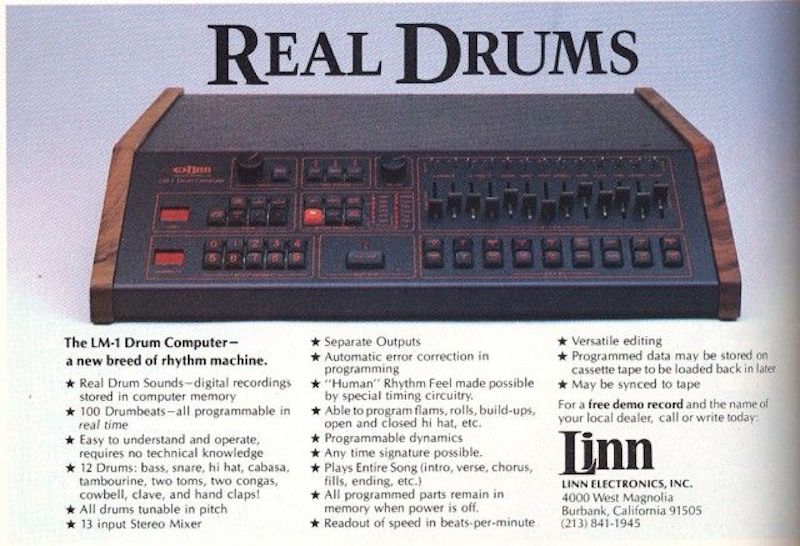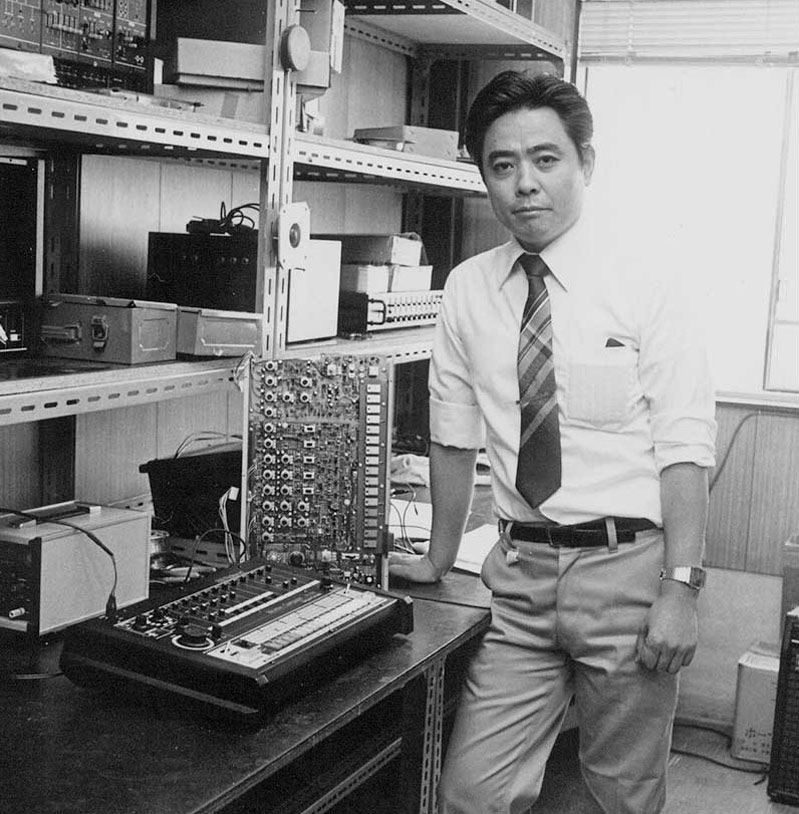The Roland TR-808 was never meant to change music. Designed as an affordable tool for making demo recordings without a drummer, it was quickly discontinued for sounding too synthetic and strange.
But where the industry saw a fatal flaw, a generation of artists found new possibilities. In the hands of boundary-pushing producers, the TR-808 helped define entirely new genres all over the world.
More than four decades later, you can hear the unmistakable influence of the TR-808 everywhere from synthpop and K-pop to techno and Memphis hip-hop.
This is how a misunderstood drum machine became one of modern music’s most enduring tools.
Origins
In the late 1970s, drum machines were a new thing, and their purpose was to replace real instruments. Machines like Roger Linn’s LM-1 Drum Computer used digital samples of real drum kits to produce realistic sounds. But the LM-1 was prohibitively expensive – only accessible to serious producers with a hefty budget for gear.

Ikutaro Kakehashi founded Roland to create musical instruments that would be accessible to all musicians, from professionals to hobbyists. So the TR-808 was designed to be a more accessible drum machine for musicians to lay down demos without hiring a drummer or booking expensive studio time.
To cut down on costs, Roland engineer Tadao Kikumoto opted for analog synthesis over sampling, allowing the TR-808 to be sold for just under $1,200—a quarter of the LM-1’s price tag.

Tadao Kikumoto with the TR-808
The TR-808 launched in 1980 and checked a lot of boxes; It was a much more affordable machine and easy to program, but the sounds it produced were jarringly artificial. These unmistakable synthetic drum sounds come from an interesting set of circumstances.
Roland used a batch of transistors that were technically functional but rejected by manufacturers for being out of specification. When semiconductor manufacturers make transistors, they test them against a list of electrical specs—like voltage gain, leakage current, and switching speed. If a transistor doesn’t meet those precise values, even by a small margin, it’s considered “out of spec.”
These imperfect transistors added unpredictable sonic quirks: a slightly distorted snare, an unusual envelope on the bass drum, or a warmer-than-expected hi-hat. In other words, they introduced character—something that was accidental and turned out to be musically expressive features.
These anomalies gave the TR-808 its particular sonic thumbprint. But the market wasn’t ready for these heavily synthesized sounds, and the TR-808 was discontinued after producing roughly 12,000 units over two years.
Roland moved on to the TR-909 and other, more “realistic” machines. But the TR-808 was only getting started.
The Early Adopters
While many mainstream studios and artists chased realism, some artists were at the cutting edge, hungry to explore new technologies and more synthesized sounds. These artists were ready to embrace the unreality of the TR-808.
Few embodied this more than Yellow Magic Orchestra. The pioneering Japanese synthpop trio—Ryuichi Sakamoto, Haruomi Hosono, and Yukihiro Takahashi—are considered to be the first to feature the TR-808 with their 1981 track “1000 Knives.”
Fusing Japanese folk motifs with cutting-edge electronic experimentation, their influence rippled far beyond Japan. YMO didn’t just help shape synthpop—they laid foundational groundwork for global electronic music and hip-hop. Without YMO, the TR-808’s path into the heart of hip-hop might have looked very different. More on that later.
Meanwhile, Marvin Gaye tapped the futuristic sound of the TR-808 for his legendary 1982 track “Sexual Healing.” The pulsing rhythm and dry robotic snare contrast with Gaye’s smooth vocals—a fusion that was radically modern. It was one of the first major pop hits to use the TR-808 so prominently and marked a huge commercial comeback for Gaye, earning him two Grammys.
At the same time, Afrika Bambaataa harnessed the futuristic sounds of the TR-808 in his genre-defining track “Planet Rock.” Afrika Bambaataa drew inspiration from Yellow Magic Orchestra as well as Germany’s iconic Kraftwerk to create a track that sounded like nothing before it.
The result was revolutionary: electro was born and the groundwork for hip-hop was laid. Bambaataa’s use of the TR-808 was massively influential for decades to come, but that’s not the only reason why he’s called the Godfather of Hip-Hop. He had a vision for his community in the Bronx – He was the first to define the four pillars of hip-hop (DJing, MCing, breakdancing, and graffiti) to turn hip-hop into a cultural movement, not just a music genre.
1980s: Electronic Music Takes Root
In the early to mid-’80s, the TR-808 became an essential tool in the birth of techno. In Detroit, young producers like Juan Atkins, Derrick May, and Kevin Saunderson (the Belleville Three) began fusing synth melodies with the synthetic groove of the TR-808.
Model 500 (Juan Atkins) “No UFOs (Instrumental)” (1985)
Meanwhile, in Chicago, DJs like Frankie Knuckles and Ron Hardy used the TR-808 and other drum machines at the tail end of the disco era to build hypnotic tracks that would become house music. The TR-808’s subby kicks and crispy hi-hats can be heard on Jesse Saunders’ “On and On” (1984), widely considered to be the first house music record ever pressed and released on vinyl.
Jesse Saunders “On and On” (1984)
The TR-808 gained popularity in Miami because it could create a thunderous bass that became the hallmark of yet another genre – Miami bass. Amos Larkins, The Gucci Crew II, Maggotron, and 2 Live Crew used that signature long-decay kick sound to turn the kick drum into the leading role. (Peep the “Planet Rock” sample in “Throw The D” 👀)
2 Live Crew “Throw The D” (1986)
In New Orleans, the TR-808 found yet another home in bounce music, a local phenomenon that exploded in the early 1990s. Bounce was built for parties, driven by hyper-repetitive hooks, chopped vocals, and the unmistakable pulse of the 808’s kick and snare pattern.
DJ Jubilee “Get Ready, Ready!” (1998)
This emphasis on sub-bass created a new bass-obsession that fundamentally changed the way low-end was treated in music—shifting from backbone to main character. From car stereos to club sound systems, the 808 kick became something you could feel.
1990s-2000s: Rise of the South and the New 808
By the mid-to-late 1990s, the TR-808 had become the backbone of an entirely different sound brewing in the South. In Memphis, producers like DJ Paul and Juicy J of Three 6 Mafia were using it to craft dark, lo-fi, horrorcore beats known as Memphis hip-hop.
Tommy Wright III “Meet Yo Maker” (1994)
In Atlanta, the 808 also fueled the crunk movement—but this was no longer the TR-808 we’ve been hearing thus far. Producers like Lil Jon, DJ Toomp, and Mr. Collipark used 808 kits (sampled and resampled) to create their high-octane beats.
By the time trap music emerges in the early 2000s, “808” is no longer a shorthand for Roland’s TR-808 drum machine. At this point, the 808 is pretty close to the one we know and love today.
By the mid-2000s, hardware was out and software was in. FL Studio was the go-to tool for a new generation of producers, and the very early days of online music production communities forming.
Waka Flocka Flame “Hard in da Paint” (2010)
A growing ecosystem of producer-curated or inspired sample packs were passed around in forums like Future Producers and now-defunct file-sharing platforms like LimeWire, BearShare, or Mediafire.
The 808 is now a category of sound and a key player in defining new genres and production techniques. Layered, saturated, compressed, re-pitched, gliding, distorted—the options are endless, allowing each producer to make their mark on the sound.
In the last decade, tracks like Travis Scott’s “goosebumps” have caused an absolute frenzy over the 808. Producer Cardo’s tuned 808s are alive and textural—pitching up and down to create a psychedelic and hypnotic atmosphere. This approach helped define yet another wave where the 808 sets the tone, creates atmosphere, and movement all at once.
And just like in the earliest days of the TR-808, the modern 808 continues to be both a sonic chameleon and creative spark. From established super producers like Metro Boomin and Pi’erre Bourne to the new generation of producers—Cash Cobain, Evilgiane, BNYX—the 808 is ever-present, evolving, and endlessly reinventing itself.






